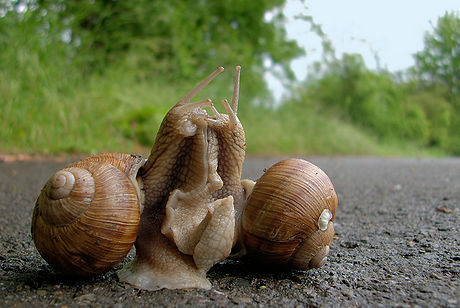Reproduction
Land snails, in comparison to marine snails, have a direct lifestyle (Hickman et al., 2009). Those animals that have a direct lifestyle do not have a larval stage, rather, the juveniles emerge as miniature adults. In a direct development lifestyle, growth emphasizes an increase in size rather the change in body shape, that is, they do not undergo metamorphosis because there is no larval stage (Hickman et al., 2009).
All pulmonates or air breathing snails are monoecious, that is, they possess both the male and female reproductive organs and can self-fertilize. However, to increase genetic diversity, it is preferred to undergo sexual reproduction. To avoid self-fertilization, spermatophores, which are bundles of sperm, are exchanged during copulation (Hickman et al., 2009).
 Based off the snail Polygyra septemvolva
Say, which can be related to the Linisa
tamaulipasensis because they are in the same
family, the snails go through a process of courtship
that may take up to 2 to 12 hours (Webb,
1950). During this phase the snails engage in a
head-on position and their tentacles shorten as they
approach one another (Webb,
1950). Their genital pores dilate and their
penis elongate followed by a series of gnawing on
one another's organ until one of the two eventually
pivots (Webb, 1950). The penises approach their mate in a twisting
fashion and sperm exchange occurs (Webb,
1950). After the exchange of sperm, the
eggs will get fertilized and eventually laid.
Based off the snail Polygyra septemvolva
Say, which can be related to the Linisa
tamaulipasensis because they are in the same
family, the snails go through a process of courtship
that may take up to 2 to 12 hours (Webb,
1950). During this phase the snails engage in a
head-on position and their tentacles shorten as they
approach one another (Webb,
1950). Their genital pores dilate and their
penis elongate followed by a series of gnawing on
one another's organ until one of the two eventually
pivots (Webb, 1950). The penises approach their mate in a twisting
fashion and sperm exchange occurs (Webb,
1950). After the exchange of sperm, the
eggs will get fertilized and eventually laid.
In Linisa
tamaulipasensis, more specifially, the primary
gonad, imbedded in the digestive gland, produces the
ova and the spermatozoa, the sex cells (Pratt,
1981). Located on the axial end of the
digestive gland is a duct called the hermaphroditic
duct which is connected to the digestive gland by a
series of lobs (Pratt, 1981).
Within the hermaphroditic ducts, the eggs are
fertilized and surrounded by a nutritive albumin, a
protein, that is produced from the albumen gland (Pratt,
1981). After the egg has been covered by
an albumin layer, it will pass through the oviduct,
be covered by a calcareous shell, and finally be
laid (Pratt, 1981).
